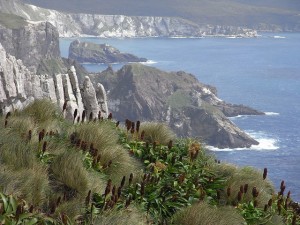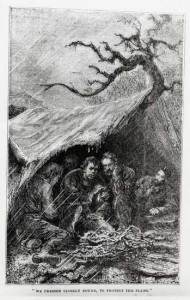It was 1864 the location, the rough desolate southern ocean between New Zealand and Antarctica. A sailing vessel, the Grafton, and small crew of five were outfitted to explore islands in the area for minerals to make tin, which was in those days, the equivalent of plastic. They left the Harbor in Sydney, Australia and headed south for Campbell Island in the spring, October, and planned to spend up to four months exploring and also bring back a cargo of the ore, or something else of value. It is significant to note that the investors had very reluctantly agreed beforehand to send a search vessel in the event they did not return after four months. In those days that would mean the investors hiring out a vessel and crew to go look for the lost ship, a prospect that would have taken many months, there was not always some navy willing to do that.
small crew of five were outfitted to explore islands in the area for minerals to make tin, which was in those days, the equivalent of plastic. They left the Harbor in Sydney, Australia and headed south for Campbell Island in the spring, October, and planned to spend up to four months exploring and also bring back a cargo of the ore, or something else of value. It is significant to note that the investors had very reluctantly agreed beforehand to send a search vessel in the event they did not return after four months. In those days that would mean the investors hiring out a vessel and crew to go look for the lost ship, a prospect that would have taken many months, there was not always some navy willing to do that.
Twenty months stranded on a sub Antarctic island
The ship was captained by Musgrave with Raynal, a Frenchman, as the first mate, three other crew were hired as cook and seamen. When they got to Campbell Island and searched it thoroughly they were unable to find any ore, so they left that island and pulled up to the Auckland Islands determined to see if there was anything there, even seals for a load of seal oil. a common commodity in those days before petroleum. As they navigated close the the shore in a sort of harbor, they dropped anchor, soon finding that the chain was not long enough nor of sturdy quality, due to tight funding of the investors, to securely grab bottom, and under gale force winds they soon crashed into the jagged rock along the shore, tearing the bottom into gaping holes.
In the end it was 20 months before rescue, during that time the investors had not made any real effort to mount a search. The crew endured through a tough winter, but it was never really warm and pleasant any time of the year. About six months after the shipwreck of the Grafton another ship, the Invercauld, a larger vessel with a crew of 25 shipwrecked on the other side of the same island. They were rescued 12 months later.
In the end both crews were rescued, but with far different results. From the Grafton all five crew survived with little long term ill effects. From the Invercauld 22 of the 25 crew died, leaving only three survivors.
There were some factors which caused the Invercauld to lose more men, these due to the type of wreck and the time of year; however, one of the most significant factors was a near total lack of leadership by the captain or anyone else. In both cases and in most survival experiences what is done in the first hours or days sets the tone, and has dramatic consequences on the outcome, be it weeks or months later. Below are a list of some critical things done or not done by each crew. The accomplishments by Captain Musgrave and his crew are truly amazing, and are due to his overall optimism and getting the most value out of each crew member. This is not to say Captain Musgrave was positive 100% of the time, there were many times all of the crew wondered if they would ever make it out of there, but optimistic thoughts and plans kept rising to the top like cream in a jar of fresh whole milk.
- Immediately set about getting all usable items from the wreckage
- Quickly set up emergency shelter for all
- Once established organized new leadership, since they weren’t on the ship anymore old positions and jobs no longer mattered. They elected Captain Musgrave as leader. This made them willing to follow him and contribute.
- Built a 16 x 24 foot shelter with wood walls and thatched with 5000 bundles of grass, it had a chimney made of stones, a wood floor, and even windows salvaged from the wreck
- Made thread by unraveling sail cloth and spinning it into new thread
- Saved a gun from the wreck to hunt seals and other animals
- When they decided to try to build a boat to escape, they built a blacksmith forge and made hundreds of nails, bolts, saw blades, other tools and needed items
- When they had extra meat they salted and smoked it to try to preserve it for times when they could get nothing.
- They started a school in the evenings, realizing that each man knew something the others did not, so they took turns teaching each other. This strengthened the bonds with each other and developed a good camaraderie.
- The ship sank at once so not much of supplies could be gathered
- The captain was despondent most of the time and made little effort to lead the crew. He continued to act as captain of a ship and the lower hands were his servants, and he did nothing
- There was no unity, almost an every man for himself attitude
- The Crew split into many factions going different directions
- Even when better circumstances were located, there was no leader encouraging the men to move on. Many lay down and died.
- There were a couple of cases of cannibalism
- There was little trust by one man of another, leading to many sleepless nights
- There was much apathy and laziness as others mimicked the captains demeanor
- If not for one lowly seaman, Holden, none would have lived. He explored found and built shelter, gathered, hunted and found food, while most of the others lay around doing nothing.
These are just a few of the significant points. Without a doubt the Invercauld would have lost many crew due to circumstances alone, however the deaths may have been half as many had Captain Dalgarno exercised the kind of leadership that Musgrave did.
In some of the courses I have taken related to survival and disaster response, it was noted that when disaster strikes the vast majority of people wait to be told what to do. It is then incumbent on each of us to train and practice to the best of our abilities, and if the need arises, to stand up and be leaders. Not to be a leader for aggrandizement, but for the welfare of all. In the stories of these two shipwrecks leadership made the difference between life and death.
Until next time, this is Perry Peacock, “Simplifying Survival”




Hey Perry…….Thanks for this article—I looked up: http://www.teara.govt.nz/en/castaways/2/2/1 for more info……..and greatly received WILDERNESS INNOVATION info. I really appreciate them eventhough I live in Cuernavaca, Mexico (45 min. south of Mexico City). This southcentral part of the country is booming with vegetation year round and get a chance to do some hiking, camping and some fishing. I´also thank you for your YOU-TUBE orientation tips which are most useful for all my outdoor activities.
thank you again and keep up your WILDERNESS INNOVATION Info coming.. “hasta mañana , amigo”……..Rafael
january 13th, 2012
Very interesting stories. This is also why whenever I am asked the question “if you & Jon were stranded on an deserted island with one other person, who would you want it to be?” my answer is always “Perry! We could survive anything with him!” 🙂
Haha
Yet ANOTHER great article, Mr. Peacock! 🙂
The contrasting stories of leadership and lack thereof were well presented by you.
I love your videos too.
I did not budget to purchase any of your items this month (January) but plan on buying the “Off Road Real Survival Kit” in mid-February. You work so hard and I appreciate your work so much so that I want to do business with you when I can.
Sincerely,
– Bill
Delayed response, haha, thanks , Bill